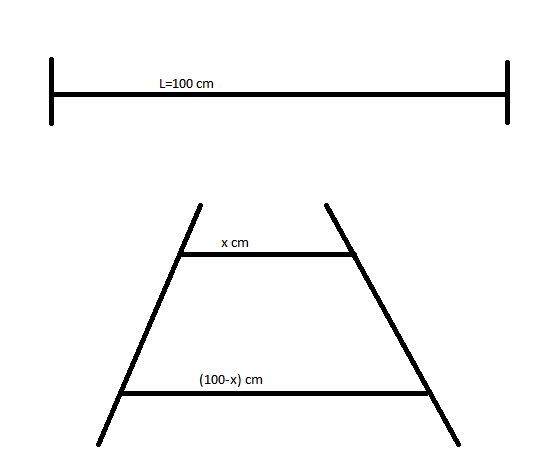Answer
414.9k+ views
Hint:-If two wires are connected in parallel the effective resistance of the combination is given by \[R = \dfrac{{{r_1}{r_2}}}{{{r_1} + {r_2}}}\]. Using this relation we get a quadratic equation and by solving the quadratic equation we get the required result.
Complete step-by-step solution:
Length of wire = \[100cm\]
\[l = 100cm\]
Resistance of wire per cm =\[\dfrac{{1\Omega }}{{cm}}\]
Resistance of wire =\[100\Omega \]
Resistance (\[r\])of wire depending upon the resistivity (\[\rho \]), length (\[l\]) and cross- sectional area (\[A\]).
\[r = \dfrac{{\rho l}}{A}\Omega \], where resistivity (\[\rho \]) and cross- sectional area (\[A\]) are constant, only length (\[l\]) is changing.

Let the wires be cut into two parts of lengths (x)cm & (100-x)cm respectively and connected in parallel as shown in the above figure.
Then their resistances are \[x\;\Omega \;\& (100 - x)\;\Omega \].
If two resistances \[{r_1}\;\& \;{r_2}\] are connected in parallel then their effective resistance is equal to \[R\]such that
\[R = \dfrac{{{r_1}{r_2}}}{{{r_1} + {r_2}}}\]
Here let
\[\
{r_1} = x\;\Omega \\
{r_2} = (100 - x)\;\Omega \\
\ \] & \[R = 24\;\Omega \]
Putting all the values in equation \[R = \dfrac{{{r_1}{r_2}}}{{{r_1} + {r_2}}}\]we get
\[ \Rightarrow 24 = \dfrac{{x(100 - x)}}{{x + (100 - x)}}\]
\[ \Rightarrow 24 = \dfrac{{100x - {x^2}}}{{100}}\]
Converting the equation into quadratic equation we get
\[ \Rightarrow 2400 = 100x - {x^2}\]
Equating the quadratic equation to zero
\[ \Rightarrow {x^2} - 100x + 2400 = 0\]
\[ \Rightarrow {x^2} - 40x - 60x + 2400 = 0\]
Factoring the quadratic equation
\[ \Rightarrow x(x - 40) - 60(x - 40) = 0\]
\[ \Rightarrow (x - 60)(x - 40) = 0\]
The two roots of the quadratic equation are
\[ \Rightarrow x = 60cm\;or\;x = 40cm\]
Hence we can take either of the values of x ,
If x=40 cm then (100-x) = 60 cm
If x=60 cm then (100-x) = 40 cm
Hence option ( B ) is the correct answer.
Hence the length of the two parts are 60 cm & 40 cm respectively.
Note:- When we connect the two resistors in parallel combination the equivalent resistance is less than the both of the individual resistors.
When we connect the two resistors in series combination the equivalent resistance is more than the both of the individual resistors.
Complete step-by-step solution:
Length of wire = \[100cm\]
\[l = 100cm\]
Resistance of wire per cm =\[\dfrac{{1\Omega }}{{cm}}\]
Resistance of wire =\[100\Omega \]
Resistance (\[r\])of wire depending upon the resistivity (\[\rho \]), length (\[l\]) and cross- sectional area (\[A\]).
\[r = \dfrac{{\rho l}}{A}\Omega \], where resistivity (\[\rho \]) and cross- sectional area (\[A\]) are constant, only length (\[l\]) is changing.

Let the wires be cut into two parts of lengths (x)cm & (100-x)cm respectively and connected in parallel as shown in the above figure.
Then their resistances are \[x\;\Omega \;\& (100 - x)\;\Omega \].
If two resistances \[{r_1}\;\& \;{r_2}\] are connected in parallel then their effective resistance is equal to \[R\]such that
\[R = \dfrac{{{r_1}{r_2}}}{{{r_1} + {r_2}}}\]
Here let
\[\
{r_1} = x\;\Omega \\
{r_2} = (100 - x)\;\Omega \\
\ \] & \[R = 24\;\Omega \]
Putting all the values in equation \[R = \dfrac{{{r_1}{r_2}}}{{{r_1} + {r_2}}}\]we get
\[ \Rightarrow 24 = \dfrac{{x(100 - x)}}{{x + (100 - x)}}\]
\[ \Rightarrow 24 = \dfrac{{100x - {x^2}}}{{100}}\]
Converting the equation into quadratic equation we get
\[ \Rightarrow 2400 = 100x - {x^2}\]
Equating the quadratic equation to zero
\[ \Rightarrow {x^2} - 100x + 2400 = 0\]
\[ \Rightarrow {x^2} - 40x - 60x + 2400 = 0\]
Factoring the quadratic equation
\[ \Rightarrow x(x - 40) - 60(x - 40) = 0\]
\[ \Rightarrow (x - 60)(x - 40) = 0\]
The two roots of the quadratic equation are
\[ \Rightarrow x = 60cm\;or\;x = 40cm\]
Hence we can take either of the values of x ,
If x=40 cm then (100-x) = 60 cm
If x=60 cm then (100-x) = 40 cm
Hence option ( B ) is the correct answer.
Hence the length of the two parts are 60 cm & 40 cm respectively.
Note:- When we connect the two resistors in parallel combination the equivalent resistance is less than the both of the individual resistors.
When we connect the two resistors in series combination the equivalent resistance is more than the both of the individual resistors.
Recently Updated Pages
How many sigma and pi bonds are present in HCequiv class 11 chemistry CBSE

Why Are Noble Gases NonReactive class 11 chemistry CBSE

Let X and Y be the sets of all positive divisors of class 11 maths CBSE

Let x and y be 2 real numbers which satisfy the equations class 11 maths CBSE

Let x 4log 2sqrt 9k 1 + 7 and y dfrac132log 2sqrt5 class 11 maths CBSE

Let x22ax+b20 and x22bx+a20 be two equations Then the class 11 maths CBSE

Trending doubts
Fill the blanks with the suitable prepositions 1 The class 9 english CBSE

At which age domestication of animals started A Neolithic class 11 social science CBSE

Which are the Top 10 Largest Countries of the World?

Give 10 examples for herbs , shrubs , climbers , creepers

Difference between Prokaryotic cell and Eukaryotic class 11 biology CBSE

Difference Between Plant Cell and Animal Cell

Write a letter to the principal requesting him to grant class 10 english CBSE

Change the following sentences into negative and interrogative class 10 english CBSE

Fill in the blanks A 1 lakh ten thousand B 1 million class 9 maths CBSE



